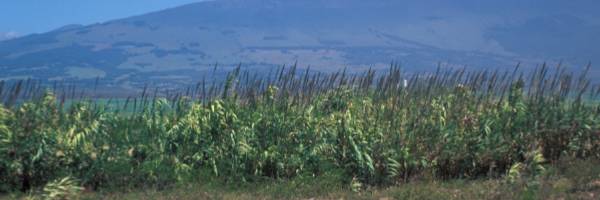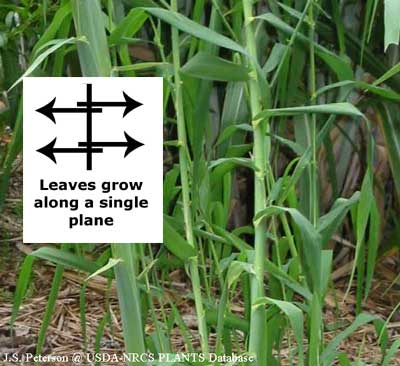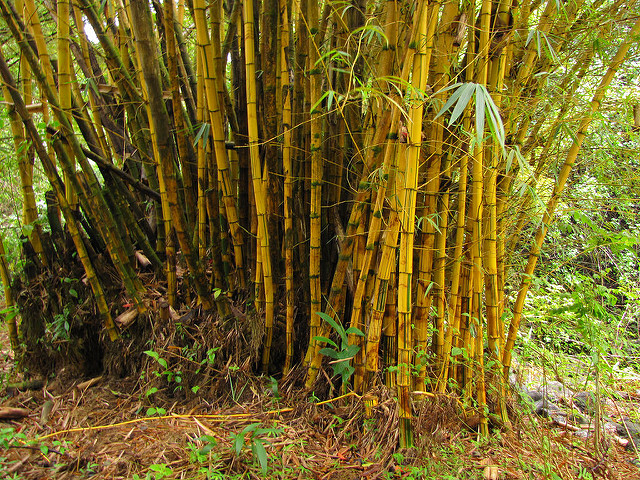Giant Reed
 Giant reed (Arundo donax)
Giant reed (Arundo donax)
Hawai‘i-Pacific Weed Risk Assessment Score: 12. Visit https://www.hpwra.org for more info
Regulatory Status: None
Prevention and control category: KISC target species
Report this species if seen on Kauai
Description
This large, clump forming grass is one of the fastest growing terrestrial plants in the world, growing 4” a day and up to 8 m (16’) tall. It has stiff leaves with a clasping connection to the stem and small hairs along the margins which are felt when the leaf is rubbed in the wrong direction. Its long leaves grow to up to 70 cm (2’) long in an alternate pattern along a single plane. Large plume shaped flowers up to (1 m) 3 ft in length develop between March and September. Forms thick masses of scaly rhizomes (horizontal underground roots) and has hollow stems.
Impacts
Giant reed grows in wet areas, such as in coastal areas, in wetlands, along streams, ditches, and rivers. Once established this grass forms impenetrable thickets that can cover several acres with clonal root masses up to 3’ thick. It outcompete all other vegetation, traps debris, reduce water flow, is a fire hazard when dry and eliminates wildlife habitat. Spreads easily by root and stem fragments floating downstream and taking root, or when dirt containing root pieces are moved (e.g. in topsoil or on heavy equipment such as bulldozers).
Distribution
- Kauaʻi: Eight known populations, mostly on the west side. KISC is working to control these populations and encourages landowners to replace these with non-invasive alternates.
- Oʻahu: Several ornamental plantings. Not currently an OISC target.
- Maui: Most populations are found in areas where rapid spread is unlikely, areas such as yards, open lots and dry streambeds. However, there is a strong possibility of this plant spreading to ideal habitat such as Keālia or Kanahā Ponds if people plant it nearby, or through the movement of dirt containing root parts, or by flooding of infested streambeds.
- Molokaʻi: Two known populations on south side have been controlled by MoMISC. Monitoring and maintenance is ongoing.

- Lanai: Presence/absence unknown
- Kahoolawe: None known
- Big Island: BIISC has no control efforts for giant reed and little is known about its distribution on the Big Island.
What you can do
If you see this species, call 643-PEST, visit www.reportapest.org or call KISC if found on Kauaʻi.
Look-alike Species:
Bamboo (Bambusoideae sp). : Bamboo is a perennial grass commonly seen on throughout Hawaiʻi. It can be distinguished from giant reed by clearly marked internodes along the stem.
: Bamboo is a perennial grass commonly seen on throughout Hawaiʻi. It can be distinguished from giant reed by clearly marked internodes along the stem.
Sugarcane (Saccharum officinarum): Sugarcane is a perennial grass with similar growth structure and leaves as giant reed. It can be distinguished from giant reed by its longer leaves arranged in an opposite pattern and its clearly marked internodes along the stem.
